Palliative Care for a Cancer Patient Research Paper 2022
VerifiedAdded on 2022/09/16
|13
|3482
|27
AI Summary
Contribute Materials
Your contribution can guide someone’s learning journey. Share your
documents today.
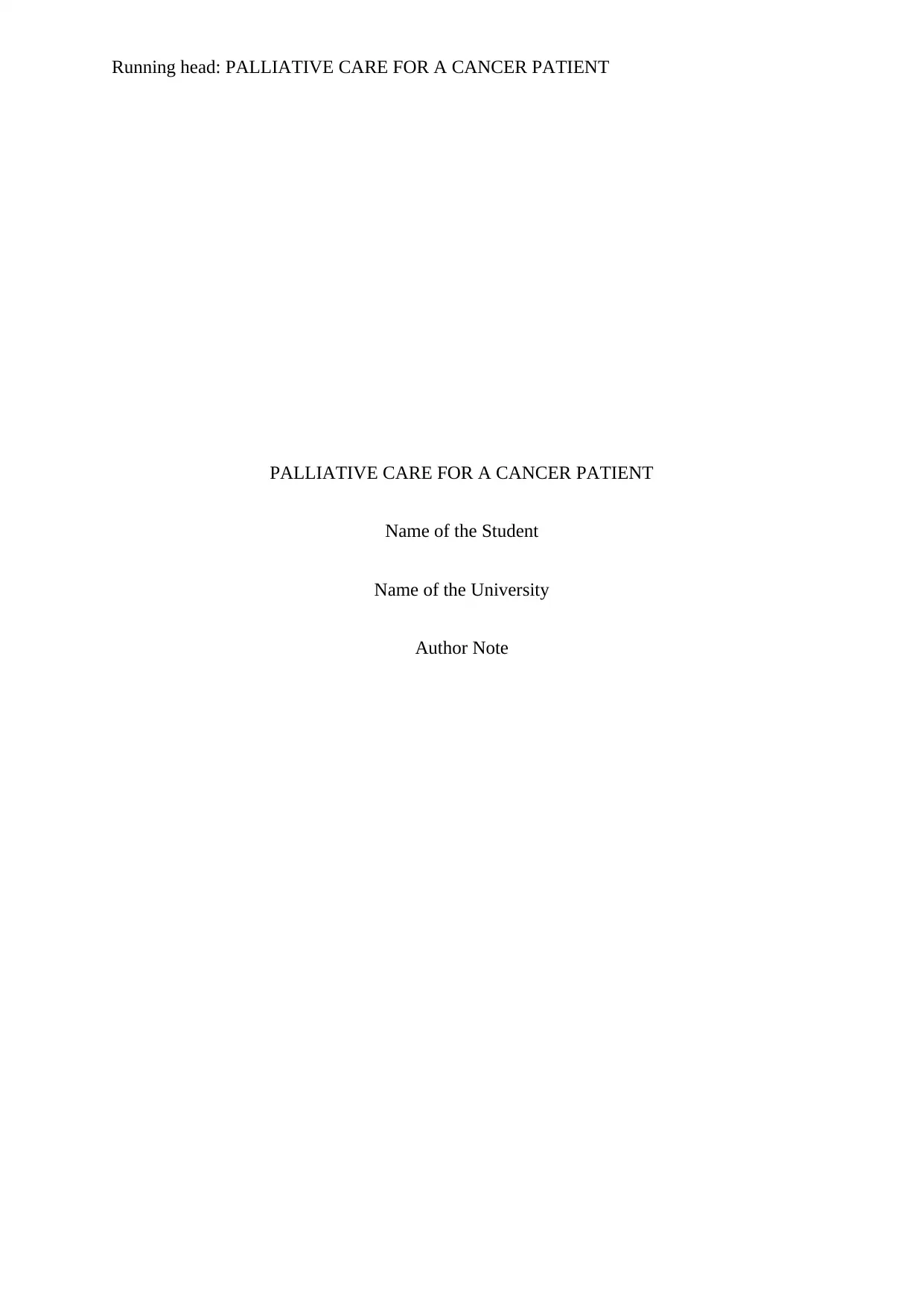
Running head: PALLIATIVE CARE FOR A CANCER PATIENT
PALLIATIVE CARE FOR A CANCER PATIENT
Name of the Student
Name of the University
Author Note
PALLIATIVE CARE FOR A CANCER PATIENT
Name of the Student
Name of the University
Author Note
Secure Best Marks with AI Grader
Need help grading? Try our AI Grader for instant feedback on your assignments.
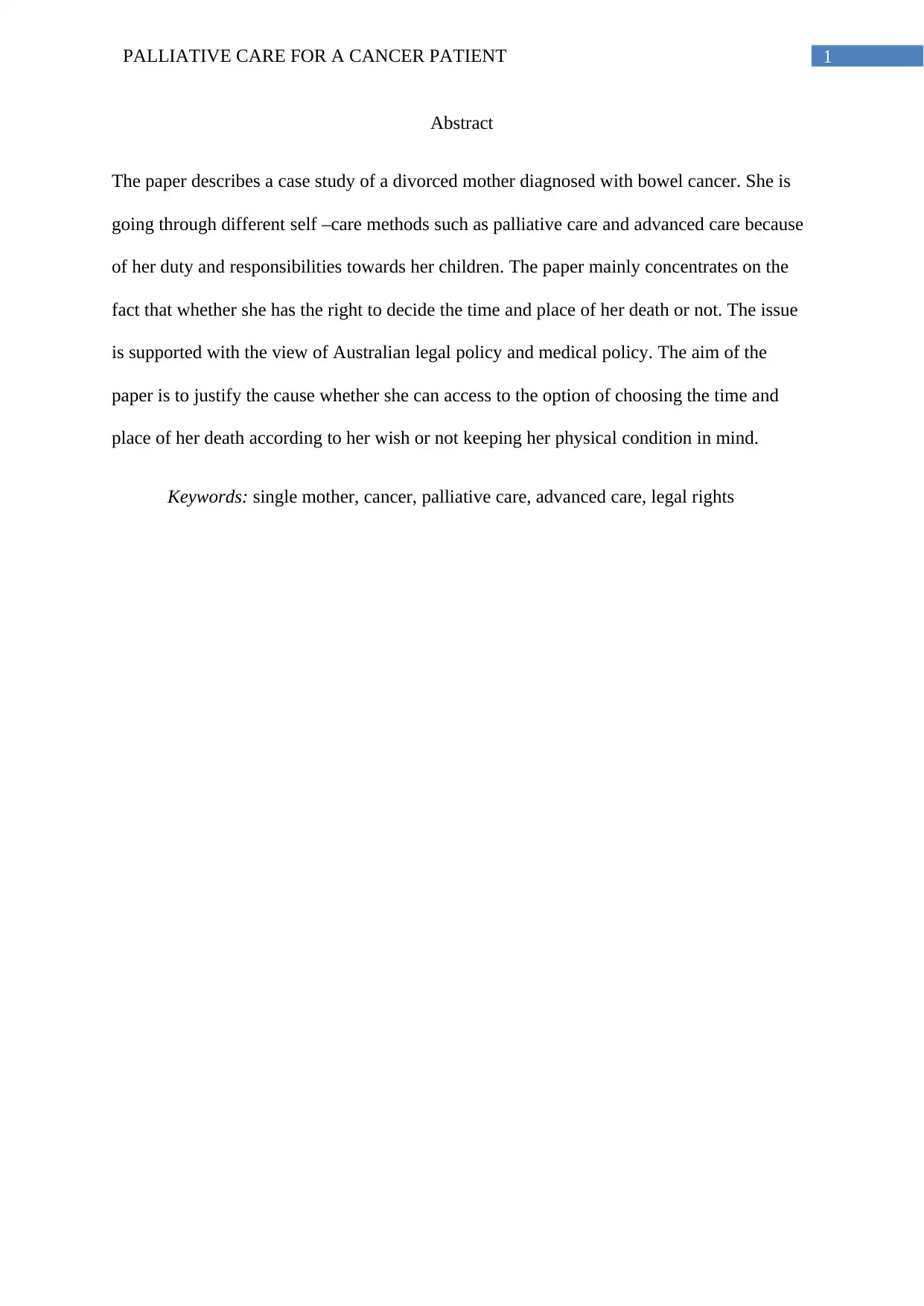
1PALLIATIVE CARE FOR A CANCER PATIENT
Abstract
The paper describes a case study of a divorced mother diagnosed with bowel cancer. She is
going through different self –care methods such as palliative care and advanced care because
of her duty and responsibilities towards her children. The paper mainly concentrates on the
fact that whether she has the right to decide the time and place of her death or not. The issue
is supported with the view of Australian legal policy and medical policy. The aim of the
paper is to justify the cause whether she can access to the option of choosing the time and
place of her death according to her wish or not keeping her physical condition in mind.
Keywords: single mother, cancer, palliative care, advanced care, legal rights
Abstract
The paper describes a case study of a divorced mother diagnosed with bowel cancer. She is
going through different self –care methods such as palliative care and advanced care because
of her duty and responsibilities towards her children. The paper mainly concentrates on the
fact that whether she has the right to decide the time and place of her death or not. The issue
is supported with the view of Australian legal policy and medical policy. The aim of the
paper is to justify the cause whether she can access to the option of choosing the time and
place of her death according to her wish or not keeping her physical condition in mind.
Keywords: single mother, cancer, palliative care, advanced care, legal rights
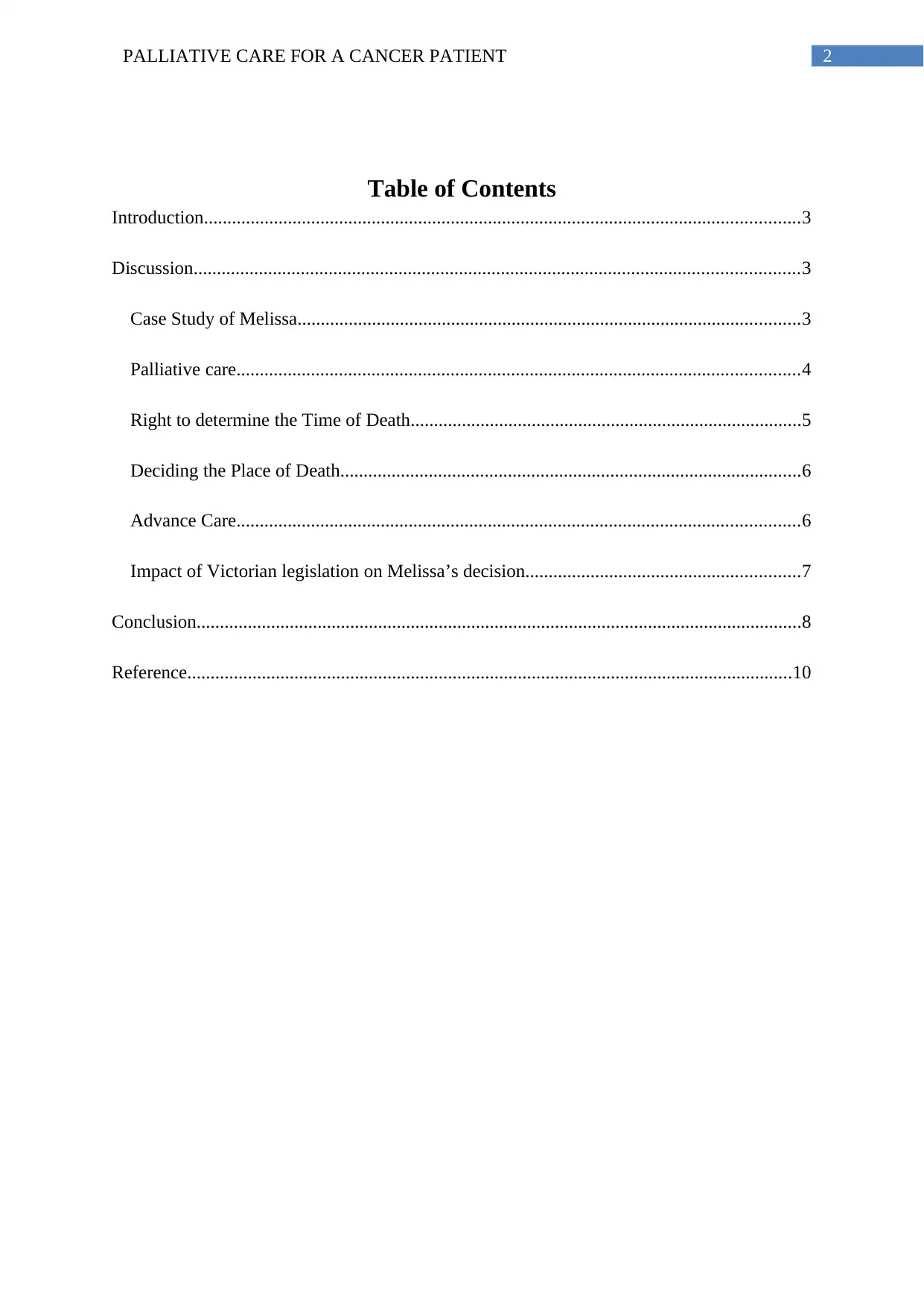
2PALLIATIVE CARE FOR A CANCER PATIENT
Table of Contents
Introduction................................................................................................................................3
Discussion..................................................................................................................................3
Case Study of Melissa............................................................................................................3
Palliative care.........................................................................................................................4
Right to determine the Time of Death....................................................................................5
Deciding the Place of Death...................................................................................................6
Advance Care.........................................................................................................................6
Impact of Victorian legislation on Melissa’s decision...........................................................7
Conclusion..................................................................................................................................8
Reference..................................................................................................................................10
Table of Contents
Introduction................................................................................................................................3
Discussion..................................................................................................................................3
Case Study of Melissa............................................................................................................3
Palliative care.........................................................................................................................4
Right to determine the Time of Death....................................................................................5
Deciding the Place of Death...................................................................................................6
Advance Care.........................................................................................................................6
Impact of Victorian legislation on Melissa’s decision...........................................................7
Conclusion..................................................................................................................................8
Reference..................................................................................................................................10
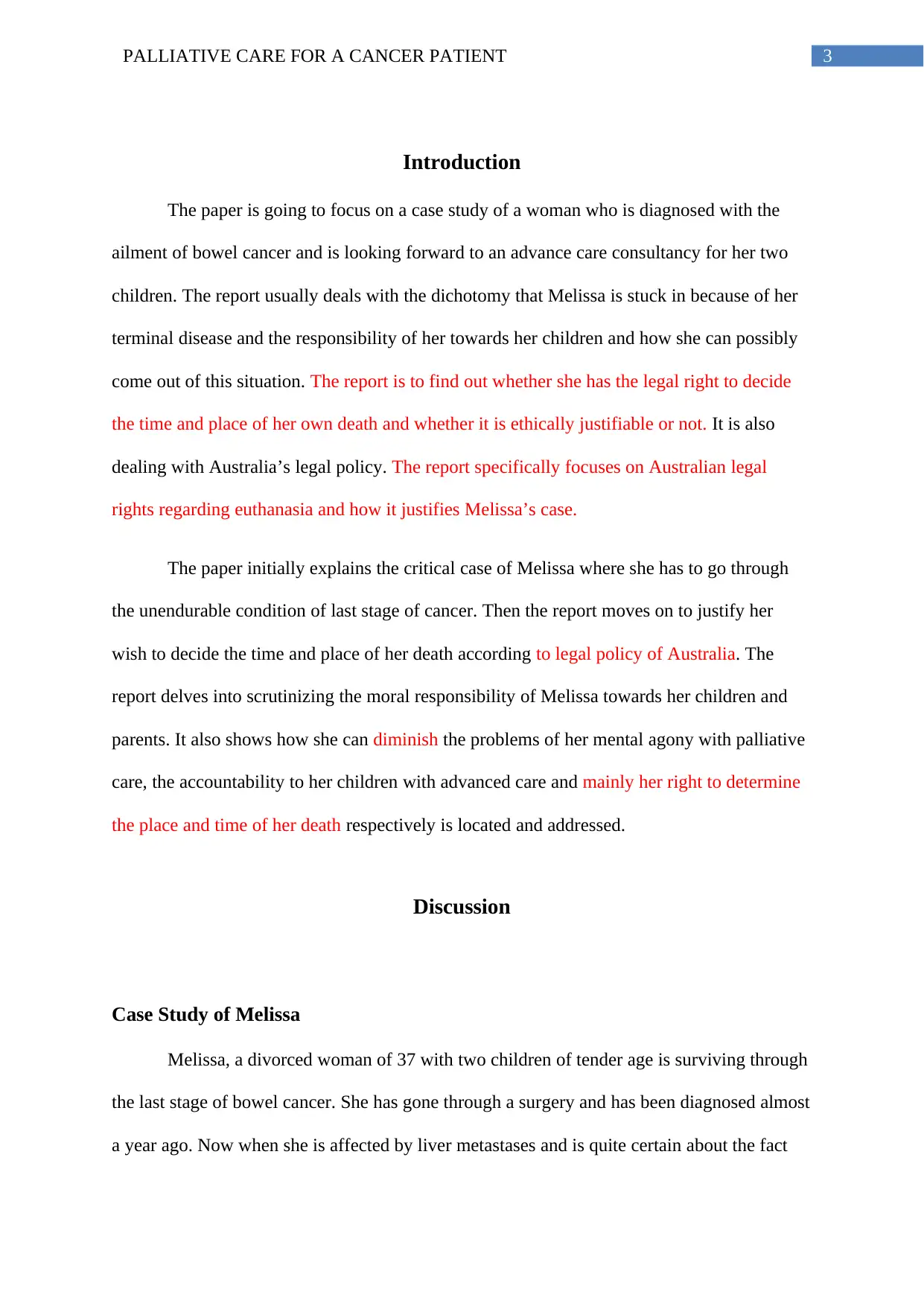
3PALLIATIVE CARE FOR A CANCER PATIENT
Introduction
The paper is going to focus on a case study of a woman who is diagnosed with the
ailment of bowel cancer and is looking forward to an advance care consultancy for her two
children. The report usually deals with the dichotomy that Melissa is stuck in because of her
terminal disease and the responsibility of her towards her children and how she can possibly
come out of this situation. The report is to find out whether she has the legal right to decide
the time and place of her own death and whether it is ethically justifiable or not. It is also
dealing with Australia’s legal policy. The report specifically focuses on Australian legal
rights regarding euthanasia and how it justifies Melissa’s case.
The paper initially explains the critical case of Melissa where she has to go through
the unendurable condition of last stage of cancer. Then the report moves on to justify her
wish to decide the time and place of her death according to legal policy of Australia. The
report delves into scrutinizing the moral responsibility of Melissa towards her children and
parents. It also shows how she can diminish the problems of her mental agony with palliative
care, the accountability to her children with advanced care and mainly her right to determine
the place and time of her death respectively is located and addressed.
Discussion
Case Study of Melissa
Melissa, a divorced woman of 37 with two children of tender age is surviving through
the last stage of bowel cancer. She has gone through a surgery and has been diagnosed almost
a year ago. Now when she is affected by liver metastases and is quite certain about the fact
Introduction
The paper is going to focus on a case study of a woman who is diagnosed with the
ailment of bowel cancer and is looking forward to an advance care consultancy for her two
children. The report usually deals with the dichotomy that Melissa is stuck in because of her
terminal disease and the responsibility of her towards her children and how she can possibly
come out of this situation. The report is to find out whether she has the legal right to decide
the time and place of her own death and whether it is ethically justifiable or not. It is also
dealing with Australia’s legal policy. The report specifically focuses on Australian legal
rights regarding euthanasia and how it justifies Melissa’s case.
The paper initially explains the critical case of Melissa where she has to go through
the unendurable condition of last stage of cancer. Then the report moves on to justify her
wish to decide the time and place of her death according to legal policy of Australia. The
report delves into scrutinizing the moral responsibility of Melissa towards her children and
parents. It also shows how she can diminish the problems of her mental agony with palliative
care, the accountability to her children with advanced care and mainly her right to determine
the place and time of her death respectively is located and addressed.
Discussion
Case Study of Melissa
Melissa, a divorced woman of 37 with two children of tender age is surviving through
the last stage of bowel cancer. She has gone through a surgery and has been diagnosed almost
a year ago. Now when she is affected by liver metastases and is quite certain about the fact
Secure Best Marks with AI Grader
Need help grading? Try our AI Grader for instant feedback on your assignments.
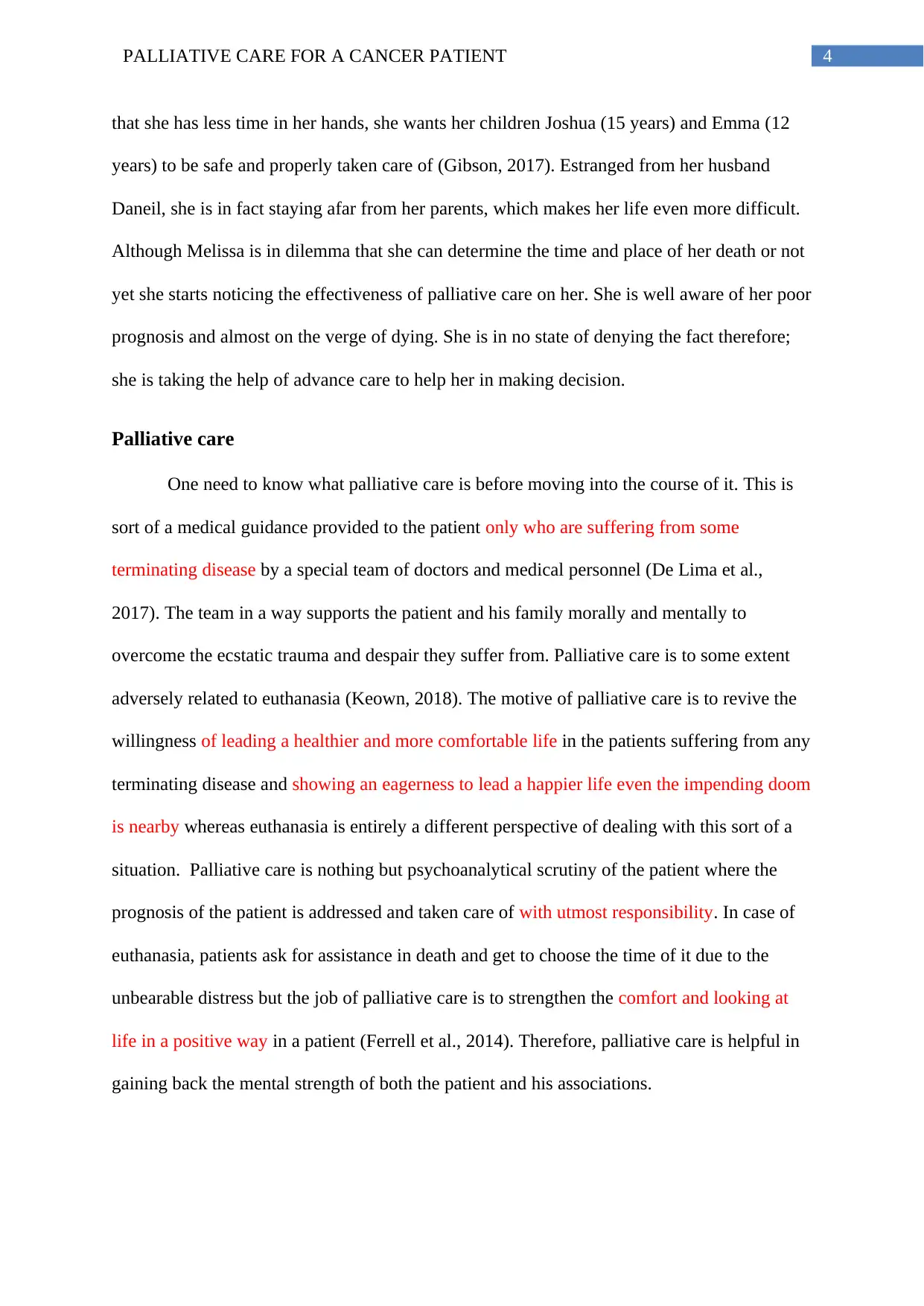
4PALLIATIVE CARE FOR A CANCER PATIENT
that she has less time in her hands, she wants her children Joshua (15 years) and Emma (12
years) to be safe and properly taken care of (Gibson, 2017). Estranged from her husband
Daneil, she is in fact staying afar from her parents, which makes her life even more difficult.
Although Melissa is in dilemma that she can determine the time and place of her death or not
yet she starts noticing the effectiveness of palliative care on her. She is well aware of her poor
prognosis and almost on the verge of dying. She is in no state of denying the fact therefore;
she is taking the help of advance care to help her in making decision.
Palliative care
One need to know what palliative care is before moving into the course of it. This is
sort of a medical guidance provided to the patient only who are suffering from some
terminating disease by a special team of doctors and medical personnel (De Lima et al.,
2017). The team in a way supports the patient and his family morally and mentally to
overcome the ecstatic trauma and despair they suffer from. Palliative care is to some extent
adversely related to euthanasia (Keown, 2018). The motive of palliative care is to revive the
willingness of leading a healthier and more comfortable life in the patients suffering from any
terminating disease and showing an eagerness to lead a happier life even the impending doom
is nearby whereas euthanasia is entirely a different perspective of dealing with this sort of a
situation. Palliative care is nothing but psychoanalytical scrutiny of the patient where the
prognosis of the patient is addressed and taken care of with utmost responsibility. In case of
euthanasia, patients ask for assistance in death and get to choose the time of it due to the
unbearable distress but the job of palliative care is to strengthen the comfort and looking at
life in a positive way in a patient (Ferrell et al., 2014). Therefore, palliative care is helpful in
gaining back the mental strength of both the patient and his associations.
that she has less time in her hands, she wants her children Joshua (15 years) and Emma (12
years) to be safe and properly taken care of (Gibson, 2017). Estranged from her husband
Daneil, she is in fact staying afar from her parents, which makes her life even more difficult.
Although Melissa is in dilemma that she can determine the time and place of her death or not
yet she starts noticing the effectiveness of palliative care on her. She is well aware of her poor
prognosis and almost on the verge of dying. She is in no state of denying the fact therefore;
she is taking the help of advance care to help her in making decision.
Palliative care
One need to know what palliative care is before moving into the course of it. This is
sort of a medical guidance provided to the patient only who are suffering from some
terminating disease by a special team of doctors and medical personnel (De Lima et al.,
2017). The team in a way supports the patient and his family morally and mentally to
overcome the ecstatic trauma and despair they suffer from. Palliative care is to some extent
adversely related to euthanasia (Keown, 2018). The motive of palliative care is to revive the
willingness of leading a healthier and more comfortable life in the patients suffering from any
terminating disease and showing an eagerness to lead a happier life even the impending doom
is nearby whereas euthanasia is entirely a different perspective of dealing with this sort of a
situation. Palliative care is nothing but psychoanalytical scrutiny of the patient where the
prognosis of the patient is addressed and taken care of with utmost responsibility. In case of
euthanasia, patients ask for assistance in death and get to choose the time of it due to the
unbearable distress but the job of palliative care is to strengthen the comfort and looking at
life in a positive way in a patient (Ferrell et al., 2014). Therefore, palliative care is helpful in
gaining back the mental strength of both the patient and his associations.
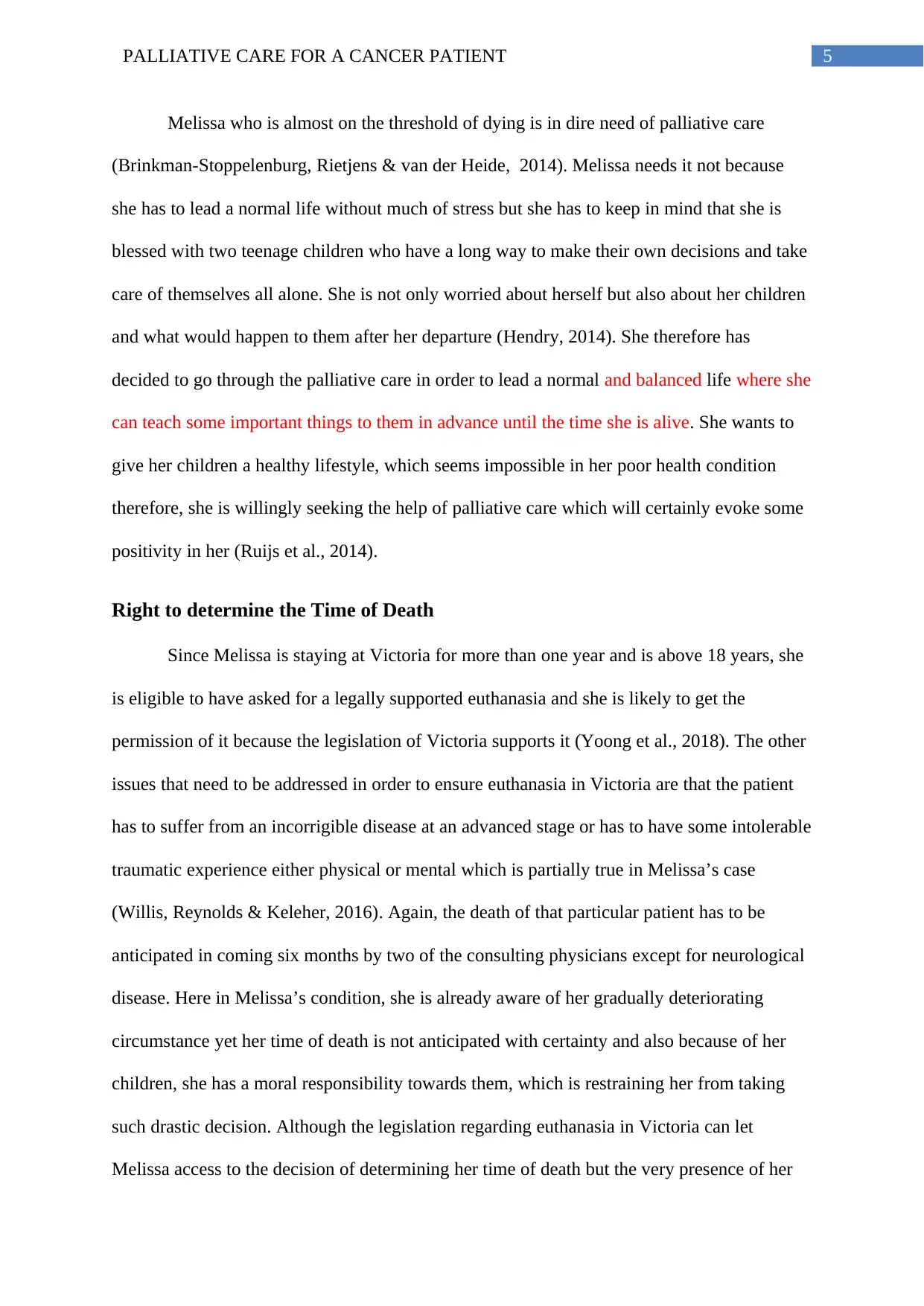
5PALLIATIVE CARE FOR A CANCER PATIENT
Melissa who is almost on the threshold of dying is in dire need of palliative care
(Brinkman-Stoppelenburg, Rietjens & van der Heide, 2014). Melissa needs it not because
she has to lead a normal life without much of stress but she has to keep in mind that she is
blessed with two teenage children who have a long way to make their own decisions and take
care of themselves all alone. She is not only worried about herself but also about her children
and what would happen to them after her departure (Hendry, 2014). She therefore has
decided to go through the palliative care in order to lead a normal and balanced life where she
can teach some important things to them in advance until the time she is alive. She wants to
give her children a healthy lifestyle, which seems impossible in her poor health condition
therefore, she is willingly seeking the help of palliative care which will certainly evoke some
positivity in her (Ruijs et al., 2014).
Right to determine the Time of Death
Since Melissa is staying at Victoria for more than one year and is above 18 years, she
is eligible to have asked for a legally supported euthanasia and she is likely to get the
permission of it because the legislation of Victoria supports it (Yoong et al., 2018). The other
issues that need to be addressed in order to ensure euthanasia in Victoria are that the patient
has to suffer from an incorrigible disease at an advanced stage or has to have some intolerable
traumatic experience either physical or mental which is partially true in Melissa’s case
(Willis, Reynolds & Keleher, 2016). Again, the death of that particular patient has to be
anticipated in coming six months by two of the consulting physicians except for neurological
disease. Here in Melissa’s condition, she is already aware of her gradually deteriorating
circumstance yet her time of death is not anticipated with certainty and also because of her
children, she has a moral responsibility towards them, which is restraining her from taking
such drastic decision. Although the legislation regarding euthanasia in Victoria can let
Melissa access to the decision of determining her time of death but the very presence of her
Melissa who is almost on the threshold of dying is in dire need of palliative care
(Brinkman-Stoppelenburg, Rietjens & van der Heide, 2014). Melissa needs it not because
she has to lead a normal life without much of stress but she has to keep in mind that she is
blessed with two teenage children who have a long way to make their own decisions and take
care of themselves all alone. She is not only worried about herself but also about her children
and what would happen to them after her departure (Hendry, 2014). She therefore has
decided to go through the palliative care in order to lead a normal and balanced life where she
can teach some important things to them in advance until the time she is alive. She wants to
give her children a healthy lifestyle, which seems impossible in her poor health condition
therefore, she is willingly seeking the help of palliative care which will certainly evoke some
positivity in her (Ruijs et al., 2014).
Right to determine the Time of Death
Since Melissa is staying at Victoria for more than one year and is above 18 years, she
is eligible to have asked for a legally supported euthanasia and she is likely to get the
permission of it because the legislation of Victoria supports it (Yoong et al., 2018). The other
issues that need to be addressed in order to ensure euthanasia in Victoria are that the patient
has to suffer from an incorrigible disease at an advanced stage or has to have some intolerable
traumatic experience either physical or mental which is partially true in Melissa’s case
(Willis, Reynolds & Keleher, 2016). Again, the death of that particular patient has to be
anticipated in coming six months by two of the consulting physicians except for neurological
disease. Here in Melissa’s condition, she is already aware of her gradually deteriorating
circumstance yet her time of death is not anticipated with certainty and also because of her
children, she has a moral responsibility towards them, which is restraining her from taking
such drastic decision. Although the legislation regarding euthanasia in Victoria can let
Melissa access to the decision of determining her time of death but the very presence of her
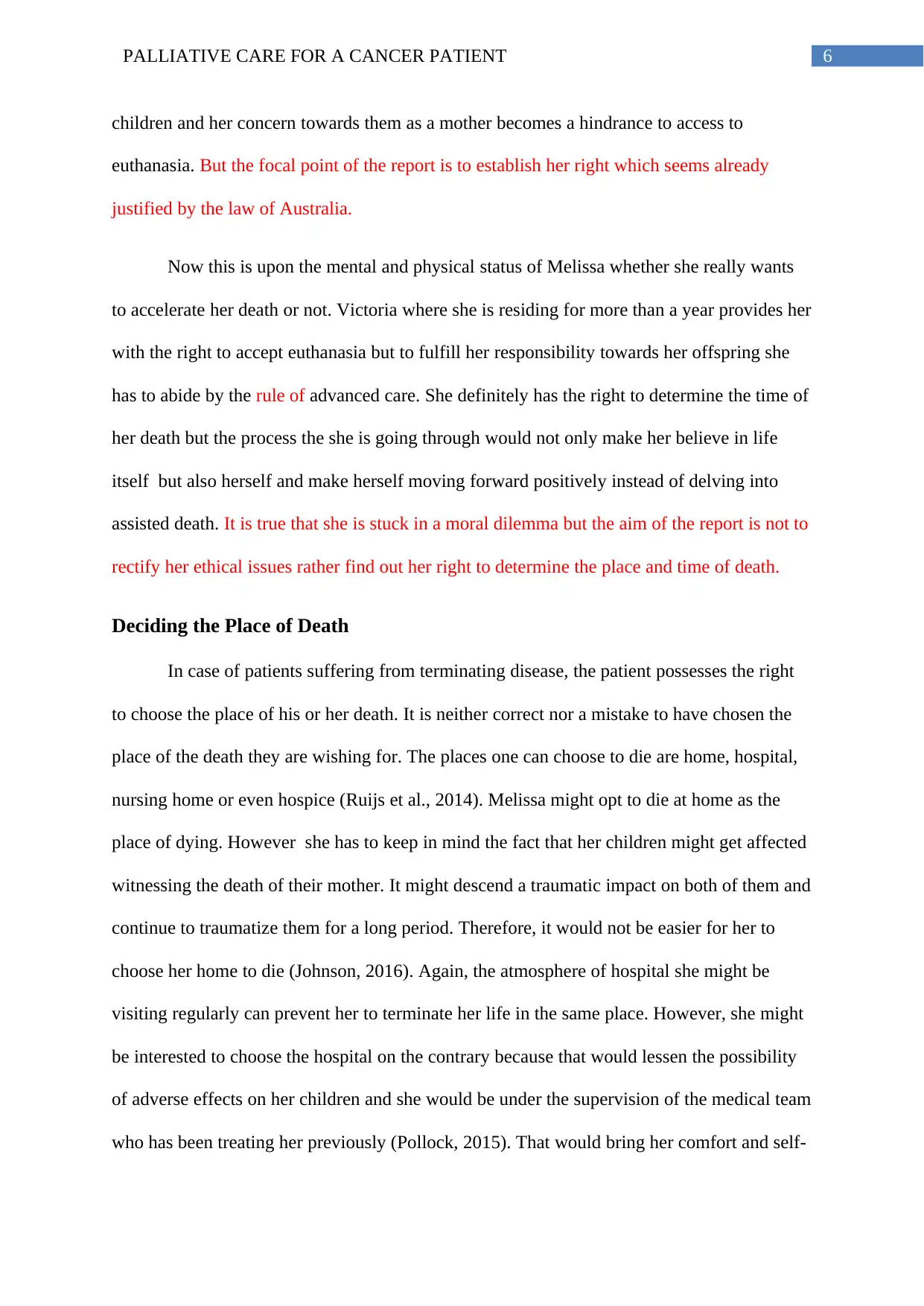
6PALLIATIVE CARE FOR A CANCER PATIENT
children and her concern towards them as a mother becomes a hindrance to access to
euthanasia. But the focal point of the report is to establish her right which seems already
justified by the law of Australia.
Now this is upon the mental and physical status of Melissa whether she really wants
to accelerate her death or not. Victoria where she is residing for more than a year provides her
with the right to accept euthanasia but to fulfill her responsibility towards her offspring she
has to abide by the rule of advanced care. She definitely has the right to determine the time of
her death but the process the she is going through would not only make her believe in life
itself but also herself and make herself moving forward positively instead of delving into
assisted death. It is true that she is stuck in a moral dilemma but the aim of the report is not to
rectify her ethical issues rather find out her right to determine the place and time of death.
Deciding the Place of Death
In case of patients suffering from terminating disease, the patient possesses the right
to choose the place of his or her death. It is neither correct nor a mistake to have chosen the
place of the death they are wishing for. The places one can choose to die are home, hospital,
nursing home or even hospice (Ruijs et al., 2014). Melissa might opt to die at home as the
place of dying. However she has to keep in mind the fact that her children might get affected
witnessing the death of their mother. It might descend a traumatic impact on both of them and
continue to traumatize them for a long period. Therefore, it would not be easier for her to
choose her home to die (Johnson, 2016). Again, the atmosphere of hospital she might be
visiting regularly can prevent her to terminate her life in the same place. However, she might
be interested to choose the hospital on the contrary because that would lessen the possibility
of adverse effects on her children and she would be under the supervision of the medical team
who has been treating her previously (Pollock, 2015). That would bring her comfort and self-
children and her concern towards them as a mother becomes a hindrance to access to
euthanasia. But the focal point of the report is to establish her right which seems already
justified by the law of Australia.
Now this is upon the mental and physical status of Melissa whether she really wants
to accelerate her death or not. Victoria where she is residing for more than a year provides her
with the right to accept euthanasia but to fulfill her responsibility towards her offspring she
has to abide by the rule of advanced care. She definitely has the right to determine the time of
her death but the process the she is going through would not only make her believe in life
itself but also herself and make herself moving forward positively instead of delving into
assisted death. It is true that she is stuck in a moral dilemma but the aim of the report is not to
rectify her ethical issues rather find out her right to determine the place and time of death.
Deciding the Place of Death
In case of patients suffering from terminating disease, the patient possesses the right
to choose the place of his or her death. It is neither correct nor a mistake to have chosen the
place of the death they are wishing for. The places one can choose to die are home, hospital,
nursing home or even hospice (Ruijs et al., 2014). Melissa might opt to die at home as the
place of dying. However she has to keep in mind the fact that her children might get affected
witnessing the death of their mother. It might descend a traumatic impact on both of them and
continue to traumatize them for a long period. Therefore, it would not be easier for her to
choose her home to die (Johnson, 2016). Again, the atmosphere of hospital she might be
visiting regularly can prevent her to terminate her life in the same place. However, she might
be interested to choose the hospital on the contrary because that would lessen the possibility
of adverse effects on her children and she would be under the supervision of the medical team
who has been treating her previously (Pollock, 2015). That would bring her comfort and self-
Paraphrase This Document
Need a fresh take? Get an instant paraphrase of this document with our AI Paraphraser
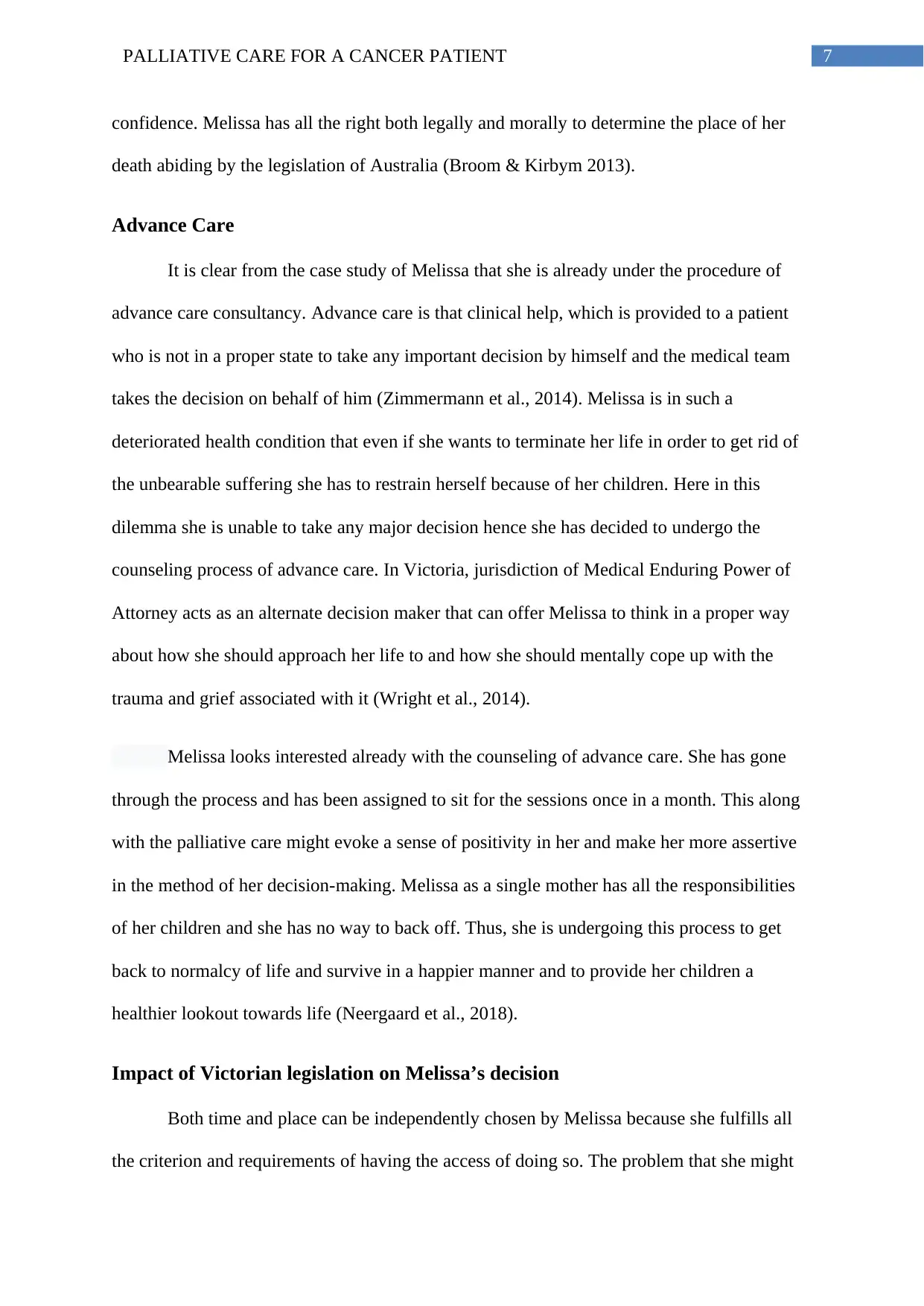
7PALLIATIVE CARE FOR A CANCER PATIENT
confidence. Melissa has all the right both legally and morally to determine the place of her
death abiding by the legislation of Australia (Broom & Kirbym 2013).
Advance Care
It is clear from the case study of Melissa that she is already under the procedure of
advance care consultancy. Advance care is that clinical help, which is provided to a patient
who is not in a proper state to take any important decision by himself and the medical team
takes the decision on behalf of him (Zimmermann et al., 2014). Melissa is in such a
deteriorated health condition that even if she wants to terminate her life in order to get rid of
the unbearable suffering she has to restrain herself because of her children. Here in this
dilemma she is unable to take any major decision hence she has decided to undergo the
counseling process of advance care. In Victoria, jurisdiction of Medical Enduring Power of
Attorney acts as an alternate decision maker that can offer Melissa to think in a proper way
about how she should approach her life to and how she should mentally cope up with the
trauma and grief associated with it (Wright et al., 2014).
Melissa looks interested already with the counseling of advance care. She has gone
through the process and has been assigned to sit for the sessions once in a month. This along
with the palliative care might evoke a sense of positivity in her and make her more assertive
in the method of her decision-making. Melissa as a single mother has all the responsibilities
of her children and she has no way to back off. Thus, she is undergoing this process to get
back to normalcy of life and survive in a happier manner and to provide her children a
healthier lookout towards life (Neergaard et al., 2018).
Impact of Victorian legislation on Melissa’s decision
Both time and place can be independently chosen by Melissa because she fulfills all
the criterion and requirements of having the access of doing so. The problem that she might
confidence. Melissa has all the right both legally and morally to determine the place of her
death abiding by the legislation of Australia (Broom & Kirbym 2013).
Advance Care
It is clear from the case study of Melissa that she is already under the procedure of
advance care consultancy. Advance care is that clinical help, which is provided to a patient
who is not in a proper state to take any important decision by himself and the medical team
takes the decision on behalf of him (Zimmermann et al., 2014). Melissa is in such a
deteriorated health condition that even if she wants to terminate her life in order to get rid of
the unbearable suffering she has to restrain herself because of her children. Here in this
dilemma she is unable to take any major decision hence she has decided to undergo the
counseling process of advance care. In Victoria, jurisdiction of Medical Enduring Power of
Attorney acts as an alternate decision maker that can offer Melissa to think in a proper way
about how she should approach her life to and how she should mentally cope up with the
trauma and grief associated with it (Wright et al., 2014).
Melissa looks interested already with the counseling of advance care. She has gone
through the process and has been assigned to sit for the sessions once in a month. This along
with the palliative care might evoke a sense of positivity in her and make her more assertive
in the method of her decision-making. Melissa as a single mother has all the responsibilities
of her children and she has no way to back off. Thus, she is undergoing this process to get
back to normalcy of life and survive in a happier manner and to provide her children a
healthier lookout towards life (Neergaard et al., 2018).
Impact of Victorian legislation on Melissa’s decision
Both time and place can be independently chosen by Melissa because she fulfills all
the criterion and requirements of having the access of doing so. The problem that she might
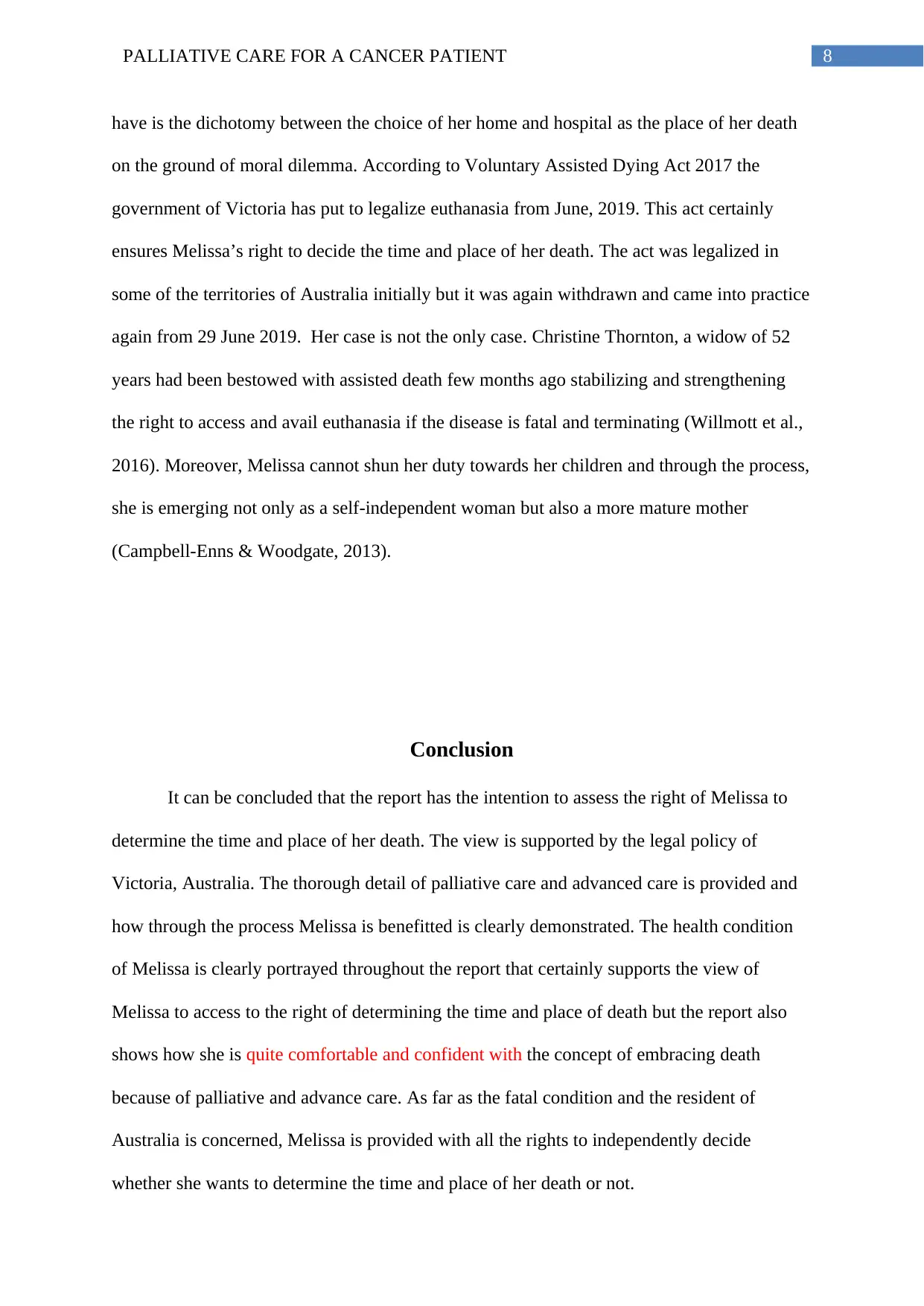
8PALLIATIVE CARE FOR A CANCER PATIENT
have is the dichotomy between the choice of her home and hospital as the place of her death
on the ground of moral dilemma. According to Voluntary Assisted Dying Act 2017 the
government of Victoria has put to legalize euthanasia from June, 2019. This act certainly
ensures Melissa’s right to decide the time and place of her death. The act was legalized in
some of the territories of Australia initially but it was again withdrawn and came into practice
again from 29 June 2019. Her case is not the only case. Christine Thornton, a widow of 52
years had been bestowed with assisted death few months ago stabilizing and strengthening
the right to access and avail euthanasia if the disease is fatal and terminating (Willmott et al.,
2016). Moreover, Melissa cannot shun her duty towards her children and through the process,
she is emerging not only as a self-independent woman but also a more mature mother
(Campbell-Enns & Woodgate, 2013).
Conclusion
It can be concluded that the report has the intention to assess the right of Melissa to
determine the time and place of her death. The view is supported by the legal policy of
Victoria, Australia. The thorough detail of palliative care and advanced care is provided and
how through the process Melissa is benefitted is clearly demonstrated. The health condition
of Melissa is clearly portrayed throughout the report that certainly supports the view of
Melissa to access to the right of determining the time and place of death but the report also
shows how she is quite comfortable and confident with the concept of embracing death
because of palliative and advance care. As far as the fatal condition and the resident of
Australia is concerned, Melissa is provided with all the rights to independently decide
whether she wants to determine the time and place of her death or not.
have is the dichotomy between the choice of her home and hospital as the place of her death
on the ground of moral dilemma. According to Voluntary Assisted Dying Act 2017 the
government of Victoria has put to legalize euthanasia from June, 2019. This act certainly
ensures Melissa’s right to decide the time and place of her death. The act was legalized in
some of the territories of Australia initially but it was again withdrawn and came into practice
again from 29 June 2019. Her case is not the only case. Christine Thornton, a widow of 52
years had been bestowed with assisted death few months ago stabilizing and strengthening
the right to access and avail euthanasia if the disease is fatal and terminating (Willmott et al.,
2016). Moreover, Melissa cannot shun her duty towards her children and through the process,
she is emerging not only as a self-independent woman but also a more mature mother
(Campbell-Enns & Woodgate, 2013).
Conclusion
It can be concluded that the report has the intention to assess the right of Melissa to
determine the time and place of her death. The view is supported by the legal policy of
Victoria, Australia. The thorough detail of palliative care and advanced care is provided and
how through the process Melissa is benefitted is clearly demonstrated. The health condition
of Melissa is clearly portrayed throughout the report that certainly supports the view of
Melissa to access to the right of determining the time and place of death but the report also
shows how she is quite comfortable and confident with the concept of embracing death
because of palliative and advance care. As far as the fatal condition and the resident of
Australia is concerned, Melissa is provided with all the rights to independently decide
whether she wants to determine the time and place of her death or not.
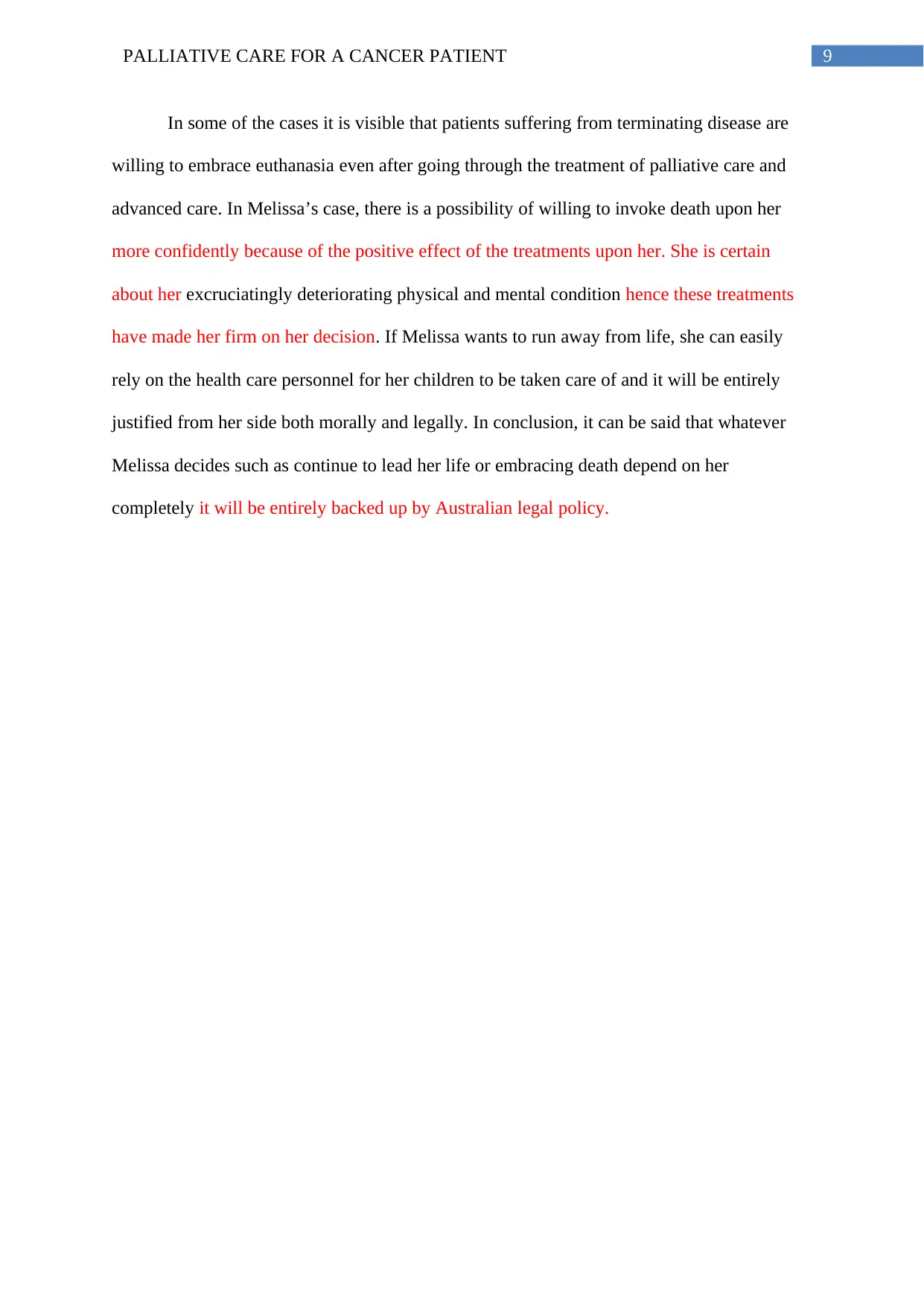
9PALLIATIVE CARE FOR A CANCER PATIENT
In some of the cases it is visible that patients suffering from terminating disease are
willing to embrace euthanasia even after going through the treatment of palliative care and
advanced care. In Melissa’s case, there is a possibility of willing to invoke death upon her
more confidently because of the positive effect of the treatments upon her. She is certain
about her excruciatingly deteriorating physical and mental condition hence these treatments
have made her firm on her decision. If Melissa wants to run away from life, she can easily
rely on the health care personnel for her children to be taken care of and it will be entirely
justified from her side both morally and legally. In conclusion, it can be said that whatever
Melissa decides such as continue to lead her life or embracing death depend on her
completely it will be entirely backed up by Australian legal policy.
In some of the cases it is visible that patients suffering from terminating disease are
willing to embrace euthanasia even after going through the treatment of palliative care and
advanced care. In Melissa’s case, there is a possibility of willing to invoke death upon her
more confidently because of the positive effect of the treatments upon her. She is certain
about her excruciatingly deteriorating physical and mental condition hence these treatments
have made her firm on her decision. If Melissa wants to run away from life, she can easily
rely on the health care personnel for her children to be taken care of and it will be entirely
justified from her side both morally and legally. In conclusion, it can be said that whatever
Melissa decides such as continue to lead her life or embracing death depend on her
completely it will be entirely backed up by Australian legal policy.
Secure Best Marks with AI Grader
Need help grading? Try our AI Grader for instant feedback on your assignments.
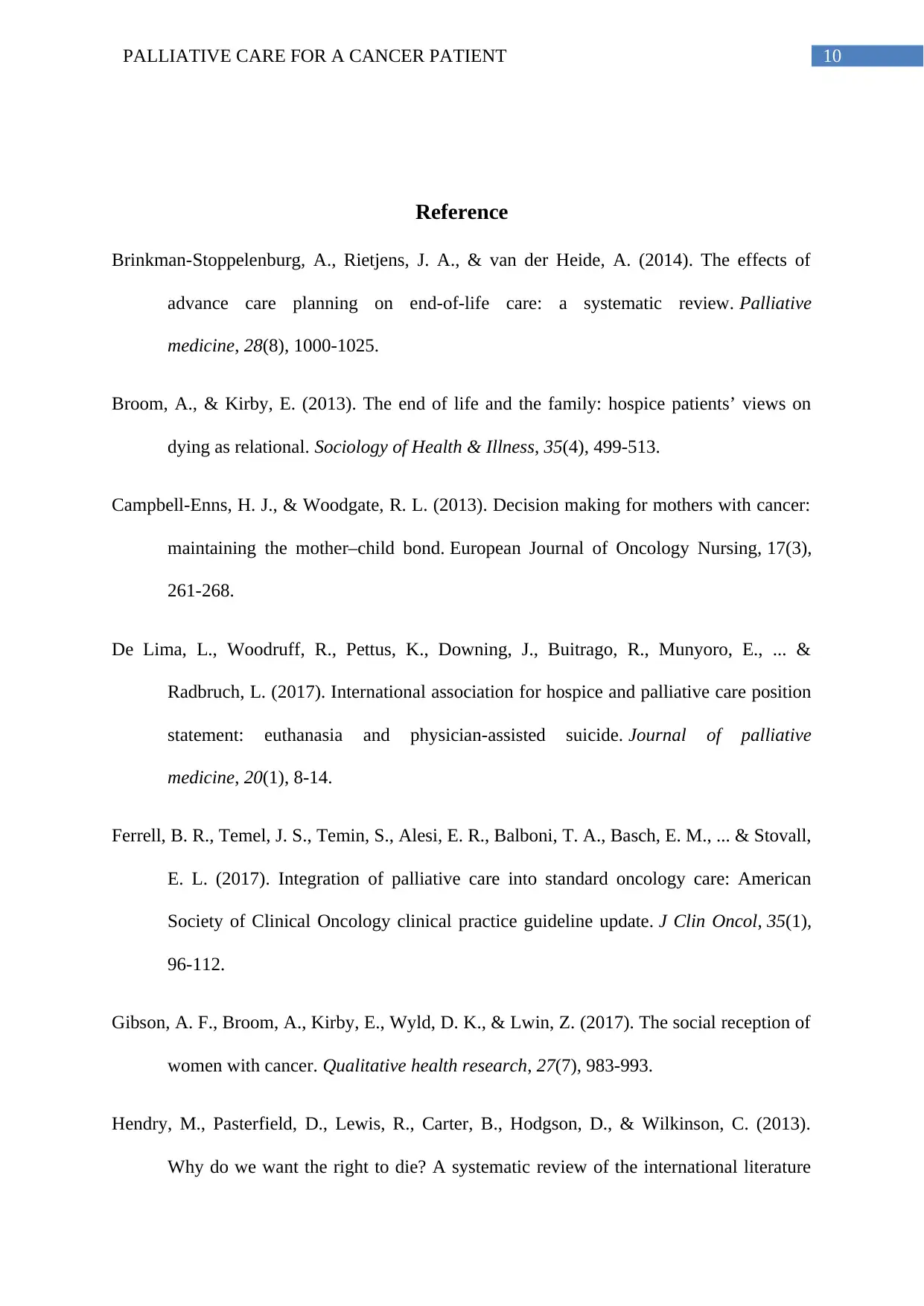
10PALLIATIVE CARE FOR A CANCER PATIENT
Reference
Brinkman-Stoppelenburg, A., Rietjens, J. A., & van der Heide, A. (2014). The effects of
advance care planning on end-of-life care: a systematic review. Palliative
medicine, 28(8), 1000-1025.
Broom, A., & Kirby, E. (2013). The end of life and the family: hospice patients’ views on
dying as relational. Sociology of Health & Illness, 35(4), 499-513.
Campbell-Enns, H. J., & Woodgate, R. L. (2013). Decision making for mothers with cancer:
maintaining the mother–child bond. European Journal of Oncology Nursing, 17(3),
261-268.
De Lima, L., Woodruff, R., Pettus, K., Downing, J., Buitrago, R., Munyoro, E., ... &
Radbruch, L. (2017). International association for hospice and palliative care position
statement: euthanasia and physician-assisted suicide. Journal of palliative
medicine, 20(1), 8-14.
Ferrell, B. R., Temel, J. S., Temin, S., Alesi, E. R., Balboni, T. A., Basch, E. M., ... & Stovall,
E. L. (2017). Integration of palliative care into standard oncology care: American
Society of Clinical Oncology clinical practice guideline update. J Clin Oncol, 35(1),
96-112.
Gibson, A. F., Broom, A., Kirby, E., Wyld, D. K., & Lwin, Z. (2017). The social reception of
women with cancer. Qualitative health research, 27(7), 983-993.
Hendry, M., Pasterfield, D., Lewis, R., Carter, B., Hodgson, D., & Wilkinson, C. (2013).
Why do we want the right to die? A systematic review of the international literature
Reference
Brinkman-Stoppelenburg, A., Rietjens, J. A., & van der Heide, A. (2014). The effects of
advance care planning on end-of-life care: a systematic review. Palliative
medicine, 28(8), 1000-1025.
Broom, A., & Kirby, E. (2013). The end of life and the family: hospice patients’ views on
dying as relational. Sociology of Health & Illness, 35(4), 499-513.
Campbell-Enns, H. J., & Woodgate, R. L. (2013). Decision making for mothers with cancer:
maintaining the mother–child bond. European Journal of Oncology Nursing, 17(3),
261-268.
De Lima, L., Woodruff, R., Pettus, K., Downing, J., Buitrago, R., Munyoro, E., ... &
Radbruch, L. (2017). International association for hospice and palliative care position
statement: euthanasia and physician-assisted suicide. Journal of palliative
medicine, 20(1), 8-14.
Ferrell, B. R., Temel, J. S., Temin, S., Alesi, E. R., Balboni, T. A., Basch, E. M., ... & Stovall,
E. L. (2017). Integration of palliative care into standard oncology care: American
Society of Clinical Oncology clinical practice guideline update. J Clin Oncol, 35(1),
96-112.
Gibson, A. F., Broom, A., Kirby, E., Wyld, D. K., & Lwin, Z. (2017). The social reception of
women with cancer. Qualitative health research, 27(7), 983-993.
Hendry, M., Pasterfield, D., Lewis, R., Carter, B., Hodgson, D., & Wilkinson, C. (2013).
Why do we want the right to die? A systematic review of the international literature
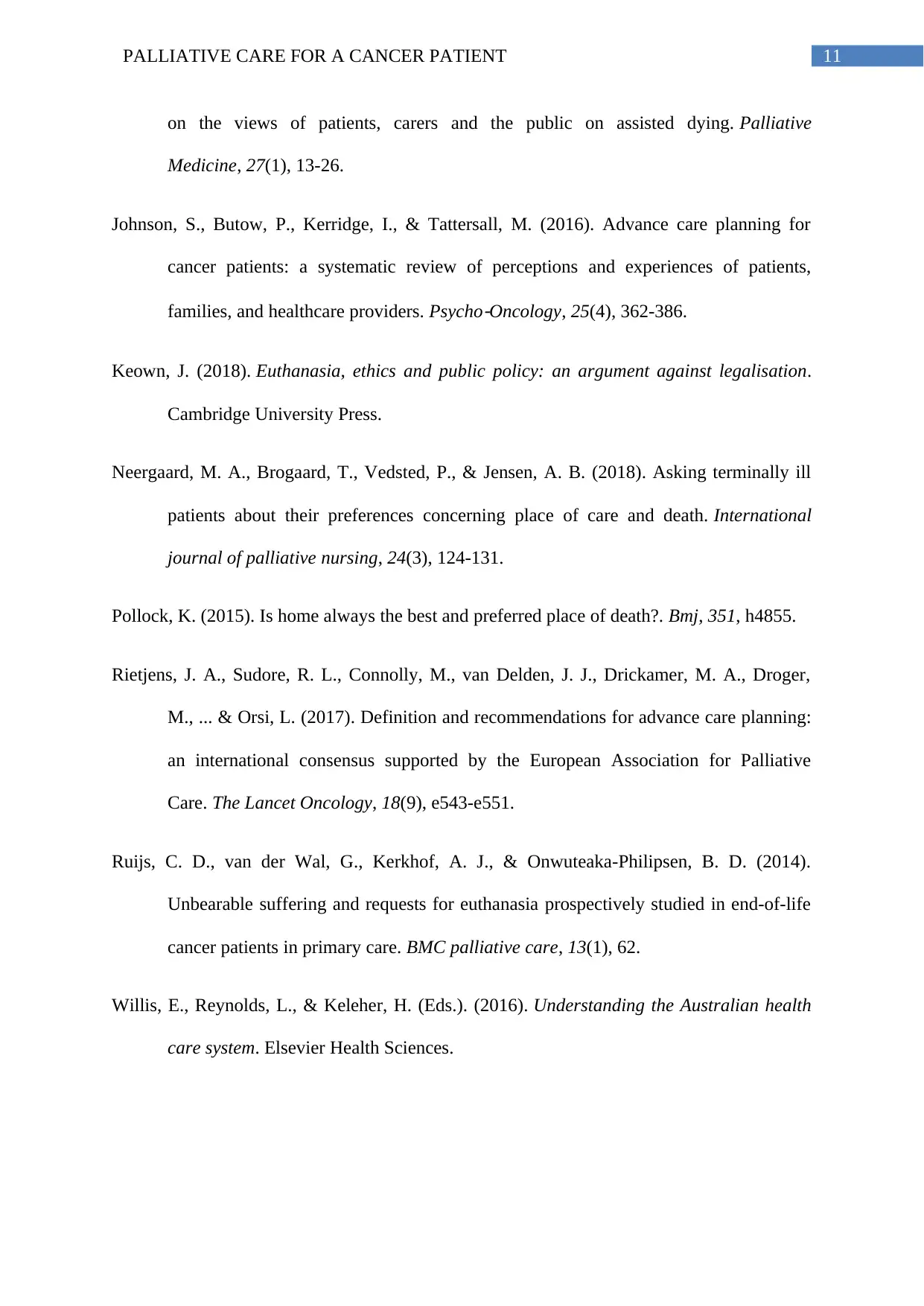
11PALLIATIVE CARE FOR A CANCER PATIENT
on the views of patients, carers and the public on assisted dying. Palliative
Medicine, 27(1), 13-26.
Johnson, S., Butow, P., Kerridge, I., & Tattersall, M. (2016). Advance care planning for
cancer patients: a systematic review of perceptions and experiences of patients,
families, and healthcare providers. Psycho
‐Oncology, 25(4), 362-386.
Keown, J. (2018). Euthanasia, ethics and public policy: an argument against legalisation.
Cambridge University Press.
Neergaard, M. A., Brogaard, T., Vedsted, P., & Jensen, A. B. (2018). Asking terminally ill
patients about their preferences concerning place of care and death. International
journal of palliative nursing, 24(3), 124-131.
Pollock, K. (2015). Is home always the best and preferred place of death?. Bmj, 351, h4855.
Rietjens, J. A., Sudore, R. L., Connolly, M., van Delden, J. J., Drickamer, M. A., Droger,
M., ... & Orsi, L. (2017). Definition and recommendations for advance care planning:
an international consensus supported by the European Association for Palliative
Care. The Lancet Oncology, 18(9), e543-e551.
Ruijs, C. D., van der Wal, G., Kerkhof, A. J., & Onwuteaka-Philipsen, B. D. (2014).
Unbearable suffering and requests for euthanasia prospectively studied in end-of-life
cancer patients in primary care. BMC palliative care, 13(1), 62.
Willis, E., Reynolds, L., & Keleher, H. (Eds.). (2016). Understanding the Australian health
care system. Elsevier Health Sciences.
on the views of patients, carers and the public on assisted dying. Palliative
Medicine, 27(1), 13-26.
Johnson, S., Butow, P., Kerridge, I., & Tattersall, M. (2016). Advance care planning for
cancer patients: a systematic review of perceptions and experiences of patients,
families, and healthcare providers. Psycho
‐Oncology, 25(4), 362-386.
Keown, J. (2018). Euthanasia, ethics and public policy: an argument against legalisation.
Cambridge University Press.
Neergaard, M. A., Brogaard, T., Vedsted, P., & Jensen, A. B. (2018). Asking terminally ill
patients about their preferences concerning place of care and death. International
journal of palliative nursing, 24(3), 124-131.
Pollock, K. (2015). Is home always the best and preferred place of death?. Bmj, 351, h4855.
Rietjens, J. A., Sudore, R. L., Connolly, M., van Delden, J. J., Drickamer, M. A., Droger,
M., ... & Orsi, L. (2017). Definition and recommendations for advance care planning:
an international consensus supported by the European Association for Palliative
Care. The Lancet Oncology, 18(9), e543-e551.
Ruijs, C. D., van der Wal, G., Kerkhof, A. J., & Onwuteaka-Philipsen, B. D. (2014).
Unbearable suffering and requests for euthanasia prospectively studied in end-of-life
cancer patients in primary care. BMC palliative care, 13(1), 62.
Willis, E., Reynolds, L., & Keleher, H. (Eds.). (2016). Understanding the Australian health
care system. Elsevier Health Sciences.
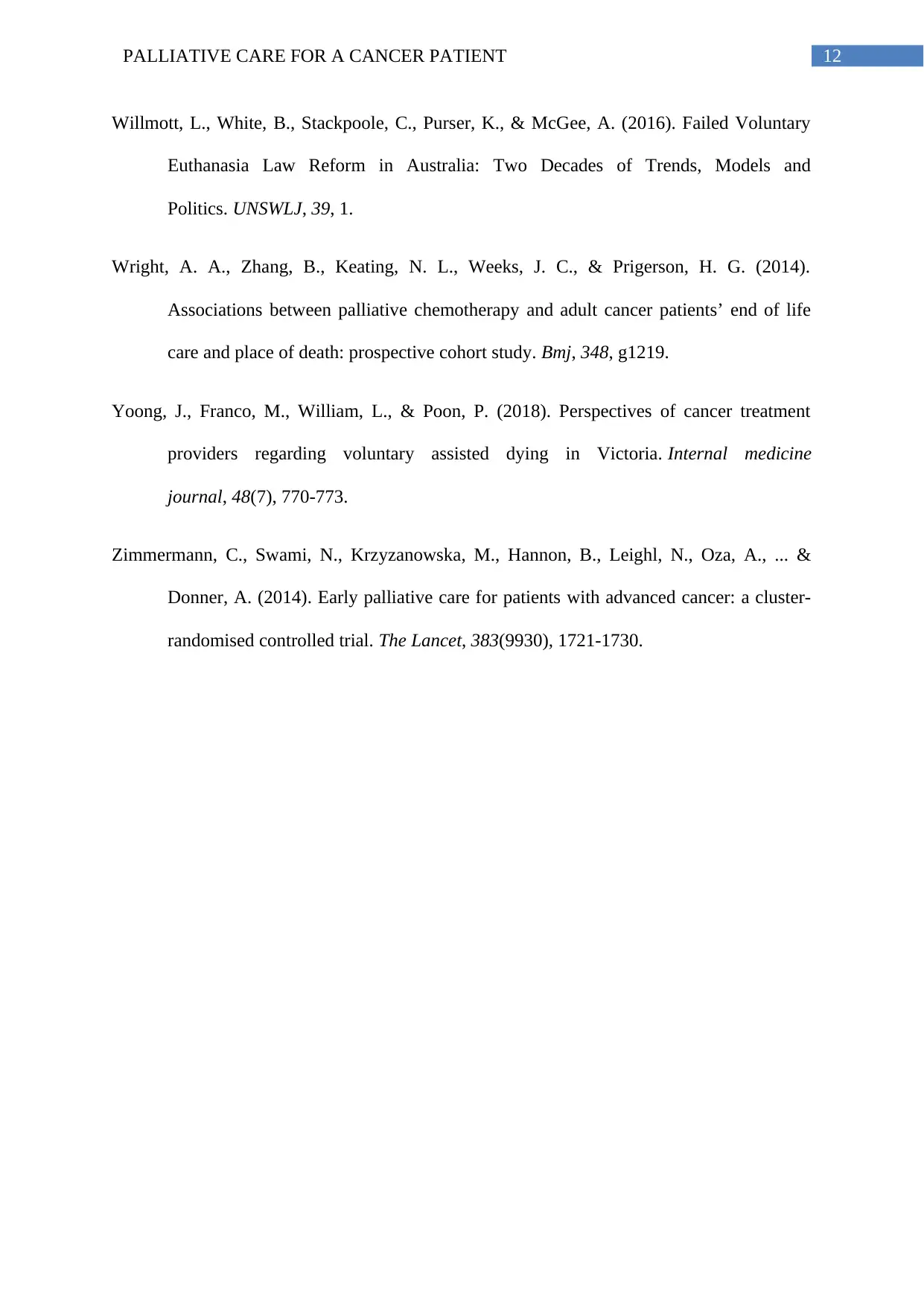
12PALLIATIVE CARE FOR A CANCER PATIENT
Willmott, L., White, B., Stackpoole, C., Purser, K., & McGee, A. (2016). Failed Voluntary
Euthanasia Law Reform in Australia: Two Decades of Trends, Models and
Politics. UNSWLJ, 39, 1.
Wright, A. A., Zhang, B., Keating, N. L., Weeks, J. C., & Prigerson, H. G. (2014).
Associations between palliative chemotherapy and adult cancer patients’ end of life
care and place of death: prospective cohort study. Bmj, 348, g1219.
Yoong, J., Franco, M., William, L., & Poon, P. (2018). Perspectives of cancer treatment
providers regarding voluntary assisted dying in Victoria. Internal medicine
journal, 48(7), 770-773.
Zimmermann, C., Swami, N., Krzyzanowska, M., Hannon, B., Leighl, N., Oza, A., ... &
Donner, A. (2014). Early palliative care for patients with advanced cancer: a cluster-
randomised controlled trial. The Lancet, 383(9930), 1721-1730.
Willmott, L., White, B., Stackpoole, C., Purser, K., & McGee, A. (2016). Failed Voluntary
Euthanasia Law Reform in Australia: Two Decades of Trends, Models and
Politics. UNSWLJ, 39, 1.
Wright, A. A., Zhang, B., Keating, N. L., Weeks, J. C., & Prigerson, H. G. (2014).
Associations between palliative chemotherapy and adult cancer patients’ end of life
care and place of death: prospective cohort study. Bmj, 348, g1219.
Yoong, J., Franco, M., William, L., & Poon, P. (2018). Perspectives of cancer treatment
providers regarding voluntary assisted dying in Victoria. Internal medicine
journal, 48(7), 770-773.
Zimmermann, C., Swami, N., Krzyzanowska, M., Hannon, B., Leighl, N., Oza, A., ... &
Donner, A. (2014). Early palliative care for patients with advanced cancer: a cluster-
randomised controlled trial. The Lancet, 383(9930), 1721-1730.
1 out of 13
Related Documents
Your All-in-One AI-Powered Toolkit for Academic Success.
+13062052269
info@desklib.com
Available 24*7 on WhatsApp / Email
![[object Object]](/_next/static/media/star-bottom.7253800d.svg)
Unlock your academic potential
© 2024 | Zucol Services PVT LTD | All rights reserved.





